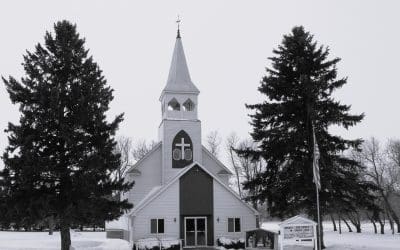Written by Pastor Martin Horn
The Theology of the Local Congregation: What is the Church?
In the previous article, we addressed the question, “why is a theology of the congregation necessary in church planting?” The answer is simple, you have to know what something is before you attempt to replicate it. Those involved in church planting must have a firm grasp of the identity and nature of the congregation before they embark in the process of planting a congregation. Theology precedes practice. This article will explore the question “What is the Church?” This, as we will see, is the foundation of the theology of the congregation. To answer the question, we will turn to the basic definitions of the Church, first from Scripture, and then from the historic confessions of the Lutheran Church.
The basic Scriptural definition of the Church is understood best from the Greek word ekklesia which we translate as Church in our English versions. Ekklesia, in its ordinary use, simply meant “a gathering or an assembly of individuals.” This helps us to know that the Church is not ultimately an institution or an organization, but it is an assembly of people who are brought together under a common bond. The question is, what is that bond or mark that identifies this gathering? What is the mark that separates this assembly from other groups?
According to Scripture, the identifying mark of the Church is faith. The writers of the New Testament repeatedly identified the Christian ekklesia as an assembly characterized by personal faith in Christ. In Acts 2, those who receive the Gospel by faith are added to the Church (Acts 2:37-41). We are justified and grafted into the people of God by faith (Romans 11:17-24). The true children of Abraham are those who are of faith (Galatians 3:7). We are sons of God through faith in Jesus Christ (Galatians 3:26). The Church is God’s “household of faith” (Galatians 6:10). Ultimately, the distinguishing mark of the Church is faith in Christ, and that the Church, in its most basic definition, is the assembly of those who are of faith.
The classic orthodox confessional statement of the doctrine of the church is found in the Nicene Creed: “I believe one holy, catholic,[1] and apostolic Church.” In this statement, the Nicene Creed further defines the church, or the “assembly of believers,” in four significant ways.
First, the Church is one. There is only one Church, regardless of the many schisms and outward divisions of the church into multitudes of separate denominations. This is because the unity of the Church is not an organizational unity but, as Sverdrup writes, a spiritual unity, a “unity in baptism by one Spirit, unity in faith in one Savior, in hope of one glory.”[2]
Second, the church is holy. According to Ephesians 6, the Church is the “pure and undefiled bride” through the atoning Sacrifice of Christ, her Divine Husband. Yes, the Holiness of the Church is often marred by sin, nevertheless the Church is holy because, as Sverdrup affirmed, it is a holiness of faith.[3]
Third, the Church is catholic or universal. This means that the church transcends all ethnic, linguistic, and national boundaries and encompasses all who believe from all peoples and from all lands. For Sverdrup, the catholicity of the Church is one of the driving forces behind world missions. In Sverdrup’s era, the church was not free of racial prejudice, and some believed missionaries need not be sent to certain so-called “inferior” races. But Sverdrup would have no part in this bigotry: “It is also a primary truth of Christianity that this [salvation] is appointed for all people, makes no distinction between them…and [the Spirit] desires to gather them all into God’s Kingdom.”[4]
Fourth, the Church is apostolic. This means that the Church is founded on the apostolic writings of the New Testament and thereby confesses the same historic faith as taught by Christ’s Apostles themselves. Some argue that the apostolicity of the Church is found in the apostolic office as it is passed down from the Church Fathers through apostolic succession. However, the significance of the apostles today is the apostolic message of the Gospel of Christ, and if we have that message, we have enough.
The Church is further defined by the Lutheran Church in article seven of the Augsburg Confession: “This [the Church] is the assembly of all believers among whom the Gospel is preached in its purity and the holy sacraments are administered according to the Gospel.”[5] According to Philip Melancthon, article seven was written in response to the Catholic teaching that defined the Church as an outward organization.
The church is not merely an association of outward ties and rites like other civic governments, however, but it is mainly an association of faith and of the Holy Spirit in men’s hearts. To make it recognizable, this association has outward marks, the pure teaching of the Gospel and the administration of the sacraments in harmony with the Gospel of Christ.[6]
The Church, Melancthon is saying, is at once both visible and invisible[7]. The Church is invisible, because membership in the Church is a matter of faith which cannot be discerned by the human eye. On the other hand, the Church is visible through the preaching of the Word and the administration of the Sacraments in the local congregation.
So, what is the Church? The Church is a spiritual fellowship that is united by a common faith in apostolic message of the Gospel of Christ. This fellowship is universal, as believers are gathered from every nation into one family as brothers and sisters in Christ. This fellowship is not known by outward marks like wealth, or power, or size, or organizational structure, but by the Spirit’s means of working in this world, the preaching of the Word and the use of the Sacraments of Baptism and the Lord’s Supper.
[1] Note that “catholic” simply means “universal” and refers to the Christ’s Church of all times and places and is distinguished from the “Roman Catholic Church.” This will be further explained below.
[2] Georg Sverdrup, “The Church and Church Organizations,” Sverdrup Journal 14 (2017): 42.
[3] Sverdrup, “Det frie Kirkesamfund,”in Professor Georg Sverdrups Samlede Skrifter i Udvalg, vol. 3, ed. Andreas Helland, Minneapolis: Frikirkens Boghandels Forlag, 1910, 65.
[4] Georg Sverdrup, “All Authority—All People—All That I Have Commanded You—To the End of the Age,” Sverdrup Journal 4 (2007): 85.
[5] Theodore G Tappert, ed., The Book of Concord: AC Art. VII, The Church, 32.
[6] Tappert, ed., The Book of Concord: Ap Art. VII, The Church, 169.
[7] Note: Luther often used the Latin abscondita or “hidden.”
The Lutheran Church PLanter
Join us on your favorite podcasting platform for church planting encouragement and practical tips.
Let's connect
Interested in learning more about how you can be part of a church planting movement in this generation? Reach out to start a discussion!
Recent Posts
Lessons Learned in a Church Plant
Lessons Learned in a Church Plant "Pastor Elden Nelson served as a previous AFLC Home Missions Director for many years. That time was a unique time...
Lessons Learned in Rural Church Ministry
Lessons Learned in Rural Church Ministry Near the beginning of his classic biography on Martin Luther (Here I Stand), Roland H. Bainton...
Why is an Intentional Formation Strategy Important? (Part 2)
Why is an Intentional Formation Strategy Important in a Congregation? (Part 2) “Repetition, repetition, repetition.” We are formed through...





0 Comments